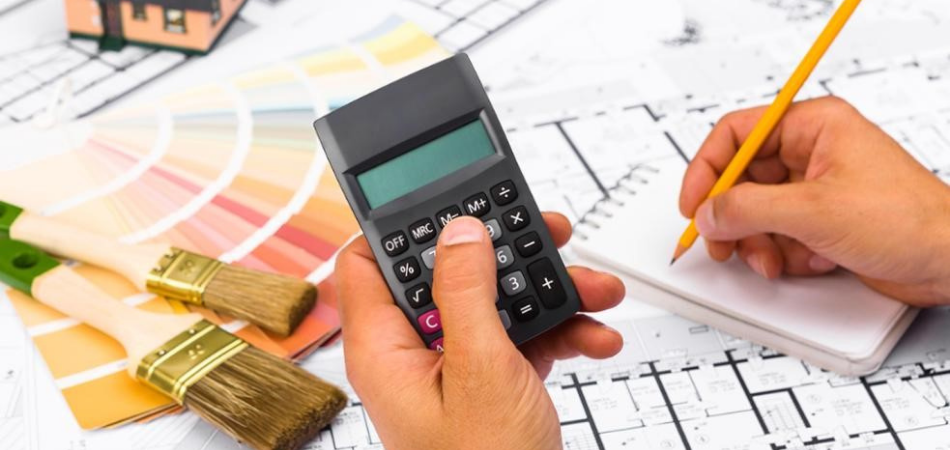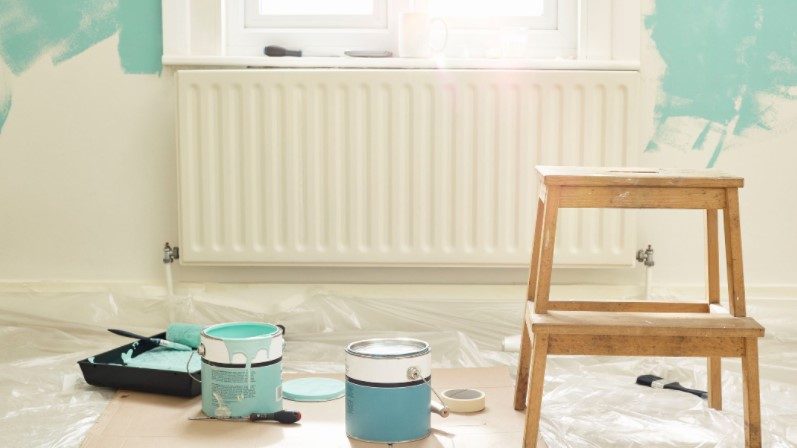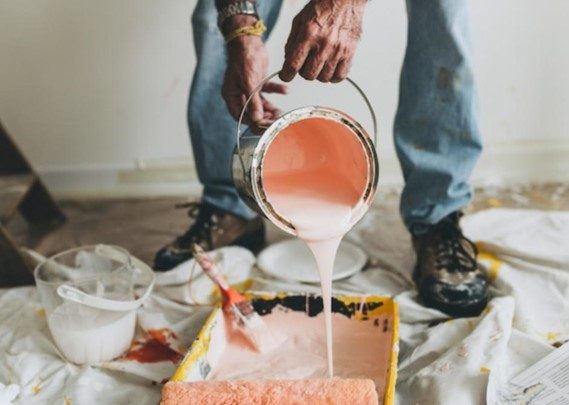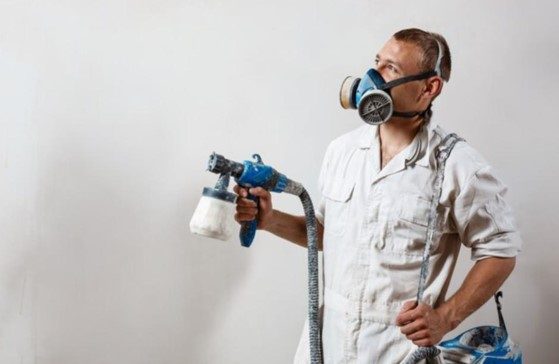Randy Charles is the owner of PaintCentric.com, a website dedicated to providing information, tips, tricks, and news about all things paint. With over 10 years...Read more
Painting a living room can be tricky! Prep is essential for success. Move furniture and cover pieces you don’t want to be painted. Consider removing light fixtures too. Let’s review the steps and associated costs for prep:
- Move furniture and cover pieces you don’t want to be painted.
- Consider removing light fixtures too.

Remove furniture and other items.
Before you start any renovation, clear the room of furniture and other stuff. Clean it completely before taking them outside. Keep dust, dirt, and debris away from the room. Put plastic drop cloths down to protect carpets or rugs from paint spills. Check the walls, ceilings, and trim for anything that needs repairing or replacing. Patch up big holes before applying primer.
Have a plan and keep track of your progress. These tips will help you improve your living space!
Prepare walls for painting
Preparing walls is essential for a good paint job. Here are the basics:
- Start by cleaning. Use a dry cloth and vacuum on newer walls. For older walls, use mild detergent, water and a scrub brush. Let surfaces dry completely.
- Fill in holes and cracks with a filler compound. Sand down until smooth, then prime. Primer will help create an even finish and seal against moisture. Wait for the primer to dry before painting.
- If wallpaper is on the wall, make sure to remove it properly. You may need professional help.
Purchase necessary supplies
Ready to make coffee? First, get the supplies. You’ll need the following:
- Beans or ground coffee
- Burr grinder
- French press/pour over dripper
- Carafe/teapot
- Filters
- Linen cloth (for Turkish coffee)
Plus, know how much you need! Generally, 1 tablespoon of freshly ground beans per person is enough.
Painting
Painting is a quick and thrifty method to give your living room a makeover. Different costs come along with painting a living room:
- The size of the room
- Type of paint
- Any necessary repairs
Knowing the expenses will help you make the best choice when sprucing up your living room.
Choose the right paint.

Picking the perfect paint for your project is essential for the desired result. The type of paint you use depends on the surface you will paint and the look you want to create.
Water-based paints like latex or vinyl acrylic are favored for walls and ceilings. They’re simple to clean up and won’t fade in the sun. What’s more, when a wall or ceiling needs a new coat of paint, usually there’s minimal preparation needed.
Oil-based paints are great for wood furniture or trim. They stick more easily and offer more protection from moisture than water-based paints. However, oil-based paints release strong odors when applied and dried, so they should be used in ventilated areas.
For outdoor surfaces like fences and shutters, exterior-grade acrylic latex paint is the way to go. It’s sturdy and holds up better to sun exposure than interior-grade paints.
If you pick the wrong type of paint or apply it badly, it may damage your home or make any repairs hard in the future. Before beginning your project, make sure to do your research and follow all directions!
Apply primer
Before painting, use a coat of primer on the walls. Primer has multiple purposes. It helps balance drywall, seals stain-killing compounds and helps paint stick better/last longer. Use a product made for drywall when buying primer. Clean all surfaces before applying. Fill any cracks with spackle/setting compound. Sand patches until smooth. Vacuum away dust after sanding. Use a wide brush/roller to apply a primer in 1 direction. Let it dry before adding another coat. Don’t spread too heavily or overbrush – it can cause texture issues when painting.
Paint walls
Painting walls is a simple and budget-friendly way to transform a room. Before you start, be sure to prepare. Please pay attention to the surfaces so they are smooth. Wipe down with a damp cloth to remove dust. Use primer on the walls to help the paint stick.
Pick quality paint formulated for wall painting. Choose between oil-based and latex-based. Decide if you want a flat or glossy finish. Flat hides imperfections but shows dirt. Glossy repels dirt but magnifies imperfections.
Tools such as brushes, rollers, trays and pans make painting easier. Work in sections, so you don’t have to go back over the same area. After painting each section, give it time to dry before moving on.
Clean Up
Before painting the living room, there are some vital steps to ensure it’s a success. Firstly, you have to prep or clean the room. This is necessary and requires both time and money.
Let’s talk about the cost of preparing the room for painting:
Clean up paint spills and splatters
Prevention is the best way to deal with paint spills and splatters. Take safety measures when painting – cover surfaces and clean up the excess before starting.
When paint splatters or spills occur, clean them quickly. It depends on the type of paint – water-based/latex, oil-based/alkyd, or solvent-based.
- For water-based/latex, mild detergent and water will do. If it is large, repaint.
- For oil-based/alkyd, use mineral spirits and a rag. Rinse with warm water after—steel wool for tougher jobs.
- For solvent-based, use acetone or nail polish remover—steel wool for tougher areas. Wear a respirator mask and rubber gloves if dealing with harsher formulas such as lacquer and enamel with high VOCs.
Clean brushes and rollers
Cleaning paint brushes and rollers is crucial for a quality finish. Clean between coats or when switching colors. This saves time and extends the life of your painting tools.
- Start by cutting off excess paint with side cutters. Dip them in cleaner or mineral spirits until all paint is loose. Scrape the excess from roller covers and soak in mineral spirits or liquid solvents. Let sit for several hours.
- Wash brushes in warm soapy water, using elbow grease to remove pigmentation. Rinse with cold water and shake out soap. Soak rollers in warm soapy water, then rinse. Wring out completely.
- Dry brushes with a clean cloth and reshape before storage. Put worn-out rollers in contractor bags and store them in dark, dry places until disposal. Don’t put these in standard wastebaskets as it poses a toxic risk!
Now you’re ready for your next coat. Good luck!

Put furniture and other items back.
Once the painting is done, the next task is to move all your furniture and stuff back in. Depending on the room’s size and complexity, this might take a while. To help with the strain of lifting, get an extra hand. Using drop cloths can minimize the cleanup.
Potential sellers should watch for paint splatters around walls and outlets. Clean up the dust particles before returning to appreciate your new living room. Vacuum or mop if needed!
Cost Estimation
Paint your living room? A great idea! But how much will it cost? You must understand the factors that can affect the price. These include the size, materials and type of paint.
Let’s explore the cost of painting a living room:
Estimate cost of paint and supplies
Paint and supplies are a must for many projects. Thus, it’s vital to know exactly what you need for the job and to estimate the cost correctly. Things to consider when estimating costs:
- What paint will you use? Oil-based or latex-based?
- How much coverage is needed? Calculate accurately, as too little paint won’t provide enough protection, but too much would be a waste of money. Plus, consider primer and bottom coats.
- Do you need special equipment such as extension poles, ladders, etc.?
- What other materials do you need? Tape, drop cloths, etc.? Don’t forget these when budgeting!
Estimate cost of labor

To determine a project’s budget, estimating labor costs is essential. Several factors affect this – skill level, experience, certifications, qualifications, base salary and hourly rate. Labor costs are calculated by multiplying hours and hourly rates, with additional costs like per Diems and subcontract suppliers considered. These estimates may vary at different stages of a construction project due to specialty labor needs and current market situations.
Regular communication between stakeholders, team leaders, and subcontractors is essential to guarantee accuracy and efficiency in determining final labor costs.
Estimate the cost of additional services (if needed)
Painting a living room comes with additional costs. Making an accurate estimate for the job requires including these costs. For example:
- I cleaned and prepped surfaces. That might include patching, filling cracks, and other tasks.
- It was stripping old paint if needed. It’s best left to professionals.
- Buying materials. Painters usually bring their supplies, like paints, primers, caulking, wall coverings, and drop cloths.
- We are repairing damaged surfaces. If caused by moisture or other damage, this must be factored in.
- They are adding additional applications. Glazes or varnishes might be extra charges.
Frequently Asked Questions
What is included in the cost of painting a living room?
The cost of painting a living room typically includes labor, supplies such as paint, primer, tape, and cleanup.
How long does it take to paint a living room?
It typically takes 2-4 days to properly paint a living room, depending on the size and condition of the room.

Randy Charles is the owner of PaintCentric.com, a website dedicated to providing information, tips, tricks, and news about all things paint. With over 10 years of experience in the painting industry, Randy has become an expert in the field and is passionate about helping others learn more about painting. He has written numerous articles on the subject and is committed to providing accurate and up-to-date information to his readers.
- Latest Posts by Randy Charles
-
How Much Do You Tip Painters? The Ultimate Guide
- -
Can You Paint Over Rust Converter?
- -
Can You Paint Inside When It Is Raining?
- All Posts
